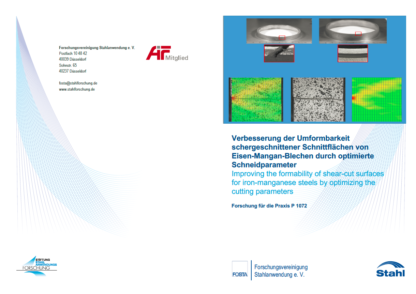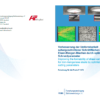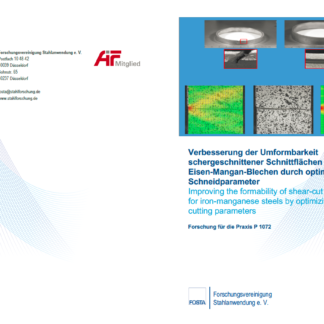Description
P 1072 – Formability improvement of shear cut surfaces of iron-manganese sheet metal by optimized cutting parameters
Increasing customer requirements and harsher global competition have created ever-growing challenges for manufacturing companies. In order to approach these problems, it is necessary to combine established and new manufacturing processes with a wide variety of materials. High-tech materials, such as high-strength and ultra-high-strength steels, are used to achieve weight and volume reduction in the final product. But these high-strength materials also present new challenges to the stable manufacturing process of pre-products, such as a rising edge-crack sensitivity.
During the shear cutting process, the structure of the material in the shear cutting zone is significantly influenced as a result of local deformations (Lange 1990; Doege und Behrens 2010). The deformed shear zone extends to sever-al tenths of a millimeter from the cut surface into the base ma-terial, depending on the sheet material and cutting parameters. This results in a reduction in the residual forming capacity of the shear influence zone (Gläsner et al. 2013).
Shear cut edges are generally further stressed in subsequent processing steps, such as the formation of flanges and the expansion of cut holes. Here, the cut surfaces are subjected to two-dimensional strain and approximately uniaxial stress. Particularly during the forming and expansion processes of multi-phase high-strength and ultra-high-strength steel materials, cracks originating from shear cut edges occur more frequently (Held et al. 2010; Kardes und Altan 2008). The formation of those so-called edge cracks is influenced by many factors. Various test methods can be used to determine the edge crack sensitivity of a material.
In addition to the only standardized test procedure, the hole expansion test according to ISO 16630, the following methods were used to characterize the edge crack sensitivity of high-manganese steels as well as dual-phase steels in the research project:
During the shear cutting process, the structure of the material in the shear cutting zone is significantly influenced as a result of local deformations (Lange 1990; Doege und Behrens 2010). The deformed shear zone extends to sever-al tenths of a millimeter from the cut surface into the base ma-terial, depending on the sheet material and cutting parameters. This results in a reduction in the residual forming capacity of the shear influence zone (Gläsner et al. 2013).
Shear cut edges are generally further stressed in subsequent processing steps, such as the formation of flanges and the expansion of cut holes. Here, the cut surfaces are subjected to two-dimensional strain and approximately uniaxial stress. Particularly during the forming and expansion processes of multi-phase high-strength and ultra-high-strength steel materials, cracks originating from shear cut edges occur more frequently (Held et al. 2010; Kardes und Altan 2008). The formation of those so-called edge cracks is influenced by many factors. Various test methods can be used to determine the edge crack sensitivity of a material.
In addition to the only standardized test procedure, the hole expansion test according to ISO 16630, the following methods were used to characterize the edge crack sensitivity of high-manganese steels as well as dual-phase steels in the research project:
- Hole expansion test with Nakajima die
- Collar forming test
- Diabolo test
- Edge-Fracture-Tensile-Test
Close coordination with the committee accompanying the project not only allowed for achieving the research objectives, but also verifying and validating a novel edge crack test method. The goal of the research project was fulfilled.
The research project was carried out at Umformtechnik und Gießereiwesen der Technischen Universität München. FOSTA has accompanied the research work and has organized the project funding from the Foundation of Steel Application Research, Essen.
The research project was carried out at Umformtechnik und Gießereiwesen der Technischen Universität München. FOSTA has accompanied the research work and has organized the project funding from the Foundation of Steel Application Research, Essen.
Only available in german language.
Published in:
December 2018
December 2018




